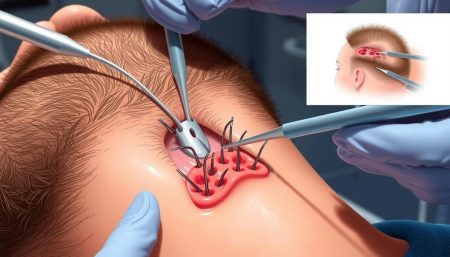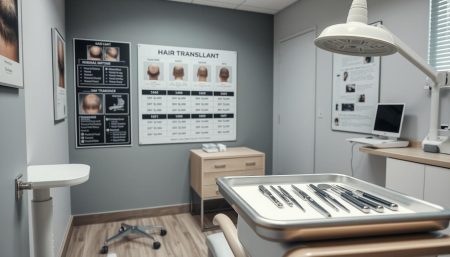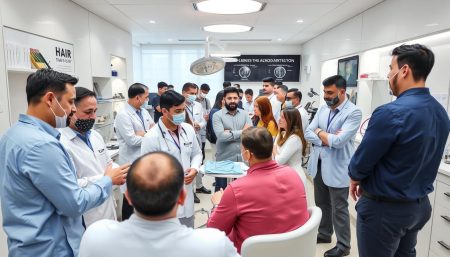Hair loss is a big problem in Britain, affecting millions. Many turn to hair transplants for a solution. The UK is home to top clinics with the latest hair restoration methods.
Hair transplantation has changed a lot in the UK. Now, you can get treatments that look very natural. We’ll look at the newest techniques, famous doctors, and what to expect in your hair restoration journey.
If you’re thinking about a hair transplant in London or the UK, this guide is for you. We’ll talk about new techniques and prices. This will help you pick the right choice for your hair needs.
Understanding Hair Transplant Surgery in the United Kingdom
Hair transplant surgery is a top choice for those wanting to fix their hairline. The UK has top-notch facilities and skilled surgeons for hair restoration. Let’s look into this modern procedure.
Types of Hair Transplant Procedures Available
In the UK, two main hair transplant methods are used:
- Follicular Unit Extraction (FUE)
- Follicular Unit Transplantation (FUT)
FUE takes single hair follicles from the donor area and puts them in the recipient area. FUT removes a scalp strip, cuts it into units, and then transplants them.
Modern Techniques and Technologies
UK clinics use the latest tech for better hair transplant results:
- Robotic hair transplantation
- Direct Hair Implantation (DHI)
- Platelet-Rich Plasma (PRP) therapy

Regulatory Framework and Safety Standards
The UK has strict rules for hair transplant clinics to keep patients safe and results high. The Care Quality Commission (CQC) checks these places. They make sure of cleanliness, staff skills, and surgery standards.
| Aspect | Regulatory Body | Key Standards |
|---|---|---|
| Clinic Registration | CQC | Mandatory registration and regular inspections |
| Surgeon Qualifications | General Medical Council | Specialist registration in plastic surgery or dermatology |
| Equipment and Facilities | MHRA | Compliance with medical device regulations |
Top-Rated Hair Transplant UK Clinics and Specialists
Choosing the right hair transplant clinic in the UK is key. We’ve found the best clinics based on patient feedback, specialist skills, and success rates.

The Harley Street Hair Clinic in London is famous for its modern techniques and famous clients. Dr. Raghu Reddy leads the clinic and is known for his FUE skills.
In Manchester, the Farjo Hair Institute has over 25 years of experience. Drs. Bessam and Nilofer Farjo are leaders in hair transplant research and training.
The Glasgow Clinic, led by Dr. Emorane Lupanzula, is known for its detailed work and natural results. They get great reviews for their hair transplants.
| Clinic | Location | Specialist | Technique | Average Rating |
|---|---|---|---|---|
| Harley Street Hair Clinic | London | Dr. Raghu Reddy | FUE | 4.9/5 |
| Farjo Hair Institute | Manchester | Dr. Bessam Farjo | FUE/FUT | 4.8/5 |
| The Glasgow Clinic | Glasgow | Dr. Emorane Lupanzula | FUE | 4.7/5 |
These clinics are known for their great results and positive feedback. When picking a clinic, look at the surgeon’s experience, the clinic’s reputation, and what other patients say. This will help you find the best place for your hair restoration.
FUE Hair Transplant: The Gold Standard in British Clinics
FUE hair transplant UK clinics have raised the standard for hair restoration. This cutting-edge method is now the top choice for many facing hair loss. Let’s look at why FUE is the top choice in British hair transplant clinics.
Benefits of FUE Treatment
FUE hair transplant London experts point out several benefits:
- Minimal scarring
- Quicker recovery time
- Natural-looking results
- Suitable for various hair types
Recovery Timeline and Process
The recovery for FUE transplants is usually simple. Most people can go back to work in a week. Here’s a quick overview:
| Time | Recovery Milestone |
|---|---|
| Day 1-3 | Rest and avoid strenuous activities |
| Day 4-7 | Resume light activities |
| Week 2-4 | Return to normal routine |
| Month 3-6 | New hair growth begins |
Expected Results and Success Rates
FUE hair transplant UK clinics have high success rates. Patients see results in 6-12 months after the procedure. The natural look and lasting results make FUE a favourite in Britain for hair restoration.
Hair Transplant Costs in London vs. Regional Clinics
Location is key when looking at hair transplant costs in the UK. London, being the capital, tends to have higher prices. The cost of a fue hair transplant in the UK can change a lot based on where you go.
In London, hair transplant prices range from £5,000 to £15,000. This is because of the top locations, modern facilities, and famous surgeons. But, regional clinics might start their prices at £3,000 to £8,000.
| Location | Average Cost Range | Factors Influencing Price |
|---|---|---|
| London | £5,000 – £15,000 | High-end facilities, experienced surgeons, prime locations |
| Regional Clinics | £3,000 – £8,000 | Lower overheads, competitive pricing, local expertise |
London clinics might seem more expensive, but they have the latest technology and top surgeons. Regional clinics, with lower costs, can offer great value.
Choosing between London and regional clinics should consider more than just price. Think about the surgeon’s skill, the clinic’s reputation, and how easy it is to get there when picking a hair transplant in the UK.
Comparing British Hair Restoration Techniques
Hair transplant UK clinics use the latest techniques for hair restoration. Each method has its own benefits, meeting different patient needs and preferences.
FUE vs. FUT Methods
Follicular Unit Extraction (FUE) and Follicular Unit Transplantation (FUT) are key hair transplant methods. FUE takes out individual hair follicles, while FUT removes a scalp strip. FUE is less invasive and causes less scarring, making it more popular in the UK.
Direct Hair Implantation (DHI)
DHI is a modern FUE method. It uses a special tool to extract and implant hair follicles in one go. This technique is becoming popular in the UK for its natural-looking results.
Robotic Hair Transplantation
Robotic systems are changing hair transplant procedures in the UK. These AI machines help surgeons place hair follicles accurately. Though not common yet, robotic hair transplantation aims for better results.
| Technique | Scarring | Recovery Time | Cost |
|---|---|---|---|
| FUE | Minimal | 1-2 weeks | Higher |
| FUT | Linear scar | 2-3 weeks | Lower |
| DHI | Minimal | 1-2 weeks | Higher |
| Robotic | Minimal | 1-2 weeks | Highest |
Choosing the right hair restoration technique depends on several factors. These include hair loss pattern, donor hair, and budget. It’s important to talk to a specialist to find the best method for you.
Patient Assessment and Consultation Process
Thinking about a hair transplant in the UK? The first step is a detailed assessment and consultation. Hair transplant clinics in the UK do thorough checks to see if you’re right for the procedure.
At your first visit, a specialist will look at your scalp and talk about your health history. They’ll check how much hair you’ve lost, if you have enough donor hair, and your overall health. This helps them make a plan just for you.
The consultation is also a chance to talk about what you can expect. Your specialist will tell you about the possible results and what the procedure can’t do. They might use special imaging to show you what you could look like after.
- Scalp examination
- Medical history review
- Discussion of hair loss patterns
- Evaluation of donor hair quality
- Explanation of suitable hair loss treatment UK options
It’s important to be open about what you want and any worries you have. This helps the clinic give you the best advice and plan. Remember, a good clinic will always put your health first, not just quick fixes.
After the assessment, you’ll get a detailed plan for your treatment. This will include what procedure you need, what results you might see, costs, and how to care for your hair after. Take your time to look over this information before you decide.
Recovery and Aftercare Guidelines for UK Patients
Proper aftercare is key for a successful hair transplant in the UK. It’s vital to follow specific guidelines after surgery. This ensures the best healing and results.
Post-Operative Care Instructions
Here are important steps for fue hair transplant UK patients:
- Keep the scalp clean and dry for the first few days
- Avoid touching or scratching the transplanted area
- Sleep with your head elevated for the first week
- Refrain from strenuous activities for at least two weeks
- Use prescribed medications as directed
Timeline for Visible Results
Waiting for hair transplant results takes patience. Here’s what to expect:
| Time Period | Expected Progress |
|---|---|
| 1-2 weeks | Initial shedding of transplanted hair |
| 3-4 months | New hair growth begins |
| 6-9 months | Noticeable improvement in hair density |
| 12-18 months | Full results visible |
Managing Expectations
It’s important to have realistic expectations about your hair transplant results. The procedure can greatly improve hair density. But it may not restore your hairline to its original state. Regular follow-ups with your surgeon can help monitor progress and address any concerns.
Remember, every patient’s journey is unique. Your results may vary depending on factors such as hair type, extent of hair loss, and individual healing processes.
Success Stories and Before/After Results
Hair transplant reviews in the UK often show amazing changes. Many people share their experiences, showing off their before and after photos. These stories are great for those thinking about hair restoration surgery in the UK.
One patient said, “I was unsure at first, but the results were better than I thought. My confidence has soared.” Many others who have had surgery at top clinics in Britain feel the same way.
“The natural-looking results and professional care I received were outstanding. It’s been life-changing.” – Mark, 42
Hair restoration surgery in the UK has improved a lot. Now, thanks to new techniques, results last longer and look more natural. People get thicker hairlines and more hair, making their hair look almost the same as before.
| Procedure Type | Average Hair Regrowth | Patient Satisfaction Rate |
|---|---|---|
| FUE | 60-70% | 95% |
| FUT | 50-60% | 90% |
| DHI | 65-75% | 97% |
These success stories give hope and set clear expectations for those thinking about it. They show that with the right clinic and method, big improvements in hair density and look are possible.
Choosing the Right Hair Transplant Clinic in Britain
Finding the right hair transplant clinic in the UK is a big decision. There are many clinics across the country. It’s important to do your research before choosing.
First, look at the clinic’s reputation. Check out patient reviews, before-and-after photos, and testimonials. A good clinic will have many happy clients and successful results.
The surgeon’s experience is key. Ask about their qualifications, specialisations, and how many procedures they’ve done. More experienced surgeons usually get better results and handle problems better.
Also, think about the technology the clinic uses. Modern equipment means more precise and less painful procedures. Top clinics in London, like those in hair transplantation, use the latest methods like FUE and DHI.
- Check if the clinic is registered with the Care Quality Commission (CQC)
- Ensure the surgeon is a member of professional bodies like the International Society of Hair Restoration Surgery
- Ask about the clinic’s success rates and how they handle complications
- Inquire about post-operative care and follow-up appointments
Don’t just look for the cheapest option. While cost matters, quality and safety are more important. A consultation can give you a good idea of the clinic’s approach and help you decide.
Medical Tourism vs. Local UK Hair Transplant Options
UK patients often think about staying local or going abroad for a hair transplant. They consider costs, quality, and travel issues carefully.
Cost Comparisons
Hair transplant costs in the UK are often higher than in places like Turkey, Poland, or Hungary. Many Brits look at these countries for cheaper options.
| Location | Average Cost (£) | Typical Graft Count |
|---|---|---|
| UK | 5,000 – 15,000 | 2,000 – 3,000 |
| Turkey | 1,500 – 3,000 | 2,000 – 3,000 |
| Poland | 2,500 – 5,000 | 2,000 – 3,000 |
Quality Standards
UK clinics follow strict rules from the Care Quality Commission. This ensures top-notch care. Overseas clinics might also offer good services, but standards can differ. It’s important to do your homework and look for international approvals.
Travel Considerations
Choosing a UK clinic means you’re close to home and can easily get follow-up care. Going abroad adds travel planning, time off work, and language barriers to think about. These factors are important to consider.
“I chose a UK clinic for my hair transplant. The higher cost was offset by the peace of mind and ease of aftercare,” reports a satisfied patient from Manchester.
Whether you pick a UK clinic or go abroad, doing your research is vital for good hair restoration results.
Latest Innovations in Hair Restoration Surgery
The field of hair restoration surgery in the UK is changing fast. New technologies and techniques are coming out to help patients. FUE hair transplant UK clinics are leading these changes, giving top-notch solutions for hair loss.
Automated follicle extraction devices are a big step forward. These tools help surgeons take hair follicles more accurately and quickly. This means less time in surgery and better hair growth.
Platelet-rich plasma (PRP) therapy is also becoming popular. It uses a patient’s own platelets to boost hair growth. This treatment is injected into the scalp to enhance transplant results.
Stem cell research is also exciting in hair restoration. Scientists are looking into using stem cells to grow new hair follicles. This could help those with little donor hair.
- 3D printing technology for creating personalised hairline designs
- Robotic-assisted hair transplantation for enhanced precision
- Long-hair FUE technique for immediate visual results
These new developments are changing hair restoration surgery in the UK. Patients are getting better, more natural-looking results and recovering faster. With ongoing research, the future of hair transplantation looks bright for those wanting to regain their confidence and hair.
Understanding Hair Transplant Financing Options
The cost of a hair transplant in the UK can be high. Many people look for ways to pay it off. Clinics in Britain offer different payment plans to help.
Many UK clinics have their own financing options. They let patients pay for fue hair transplants over time. These plans often have low or no interest for a while, which is good for those who can’t pay all at once.
Medical loans are another choice. Specialised lenders offer loans just for cosmetic procedures, like hair transplants. These loans have good interest rates and flexible payback times.
| Financing Option | Typical Terms | Pros | Cons |
|---|---|---|---|
| Clinic Payment Plans | 0-12% interest, 6-24 months | Convenient, often interest-free initially | Limited to specific clinic |
| Medical Loans | 5-15% APR, 1-7 years | Flexible use, longer repayment | Credit check required |
| Credit Cards | Varies widely | Immediate availability | Potentially high interest rates |
| Personal Savings | N/A | No interest or debt | May deplete emergency funds |
Some people use credit cards, which can be available right away. But, it’s important to pay off the balance before the interest gets too high.
When thinking about financing for a hair transplant, it’s important to look at all options. Consider the interest rates, how long you’ll pay it back, and your financial situation. Talking to a financial advisor can help you make a choice that fits your budget and future plans.
Common Complications and How to Avoid Them
Hair transplant UK procedures are usually safe. But, like any surgery, they can have risks. It’s important to know these risks and how to avoid them if you’re thinking about this treatment for hair loss in the UK.
Potential Risks
Common problems with hair transplants include infection, bleeding, and scarring. Some people might see their existing hair fall out temporarily, known as shock loss. Others could face issues with graft survival or results that look unnatural.
Prevention Strategies
To lower risks, pick a well-known hair transplant UK clinic with skilled surgeons. Follow all pre-operative instructions, like avoiding certain medicines and quitting smoking. Make sure the clinic keeps everything clean and sterile during the procedure.
Treatment of Complications
If problems happen, getting help quickly is key. Infections usually need antibiotics, and bleeding can be stopped with pressure. For scarring, you might need creams or another surgery. Experienced surgeons can fix problems with graft placement or hairline design.
| Complication | Prevention | Treatment |
|---|---|---|
| Infection | Strict hygiene, pre-op antibiotics | Oral antibiotics, topical treatments |
| Bleeding | Avoid blood thinners, gentle handling | Pressure application, cauterisation |
| Scarring | Proper technique, post-op care | Topical treatments, revision surgery |
By knowing these possible problems and listening to your surgeon, you can greatly reduce risks with hair transplant procedures in the UK.
Alternative Hair Loss Treatments in the UK
There are many hair loss treatments in the UK, aside from surgery. These non-surgical options help people deal with thinning or lost hair without surgery.
Medication is a common first choice. Finasteride and minoxidil, in tablet or cream form, slow hair loss and help hair grow back. You need to keep using them to keep seeing results.
Scalp micropigmentation is a cosmetic method. It makes your scalp look fuller by tattooing pigment to mimic hair follicles. It’s good for those with a lot of hair loss.
Non-surgical hair replacement systems give quick results. They are custom-made and attached to your scalp with special adhesives. They look natural and don’t need surgery.
| Treatment | Pros | Cons |
|---|---|---|
| Medication | Non-invasive, gradual results | Ongoing treatment required |
| Scalp Micropigmentation | Long-lasting, low maintenance | Limited styling options |
| Hair Replacement Systems | Immediate results, versatile | Regular maintenance needed |
These options vary in how well they work and how much effort they need. Talking to a hair loss specialist can help find the best treatment for you.
Long-term Maintenance After Hair Transplantation
After a hair transplant in the UK, it’s vital to keep up with care for lasting results. Those who get FUE hair transplant treatments need to know that aftercare is ongoing, not just after healing.
To keep your transplanted hair looking good, remember these important points:
- Regular follow-up appointments with your surgeon
- Proper hair care routine using recommended products
- Healthy lifestyle choices to support hair growth
- Potential need for future touch-up procedures
Many UK clinics have detailed aftercare plans. These include regular check-ups, scalp treatments, and advice on keeping your new hairline looking great.
| Time Frame | Maintenance Activity |
|---|---|
| First 6 months | Gentle hair washing, avoiding direct sunlight |
| 6-12 months | Regular scalp treatments, minor styling allowed |
| 1-2 years | Normal hair care routine, annual check-ups |
| 2+ years | Maintenance treatments, possible touch-ups |
Keep in mind, hair loss can happen in areas not covered by the transplant. Some might need extra treatments or procedures to keep their look. Talking about long-term plans with your hair transplant specialist is key for the best results.
Preparing for Your Hair Transplant Procedure
Getting ready for a hair transplant in the UK needs careful planning. Hair transplant clinics UK give advice to help patients prepare. Before the big day, it’s important to follow pre-operative instructions closely. This might include stopping certain medications and avoiding alcohol and smoking.
On the day of the procedure, wear comfortable clothes that don’t need to be pulled over your head. Bring essentials like loose-fitting hats or scarves to cover your head after surgery. Hair transplantation London specialists often suggest bringing a book or tablet for entertainment during the procedure.
At home, set up a recovery area with plenty of pillows to prop yourself up while sleeping. Make sure to have prescribed medications and any recommended post-operative care products. It’s wise to arrange for someone to drive you home after the surgery and possibly stay with you for the first night.
By following these steps, patients can ensure they’re well-prepared for their hair restoration journey. Hair transplant clinics UK aim to make the experience as smooth as possible, supporting patients every step of the way.
FAQ
Q: What is the average cost of a hair transplant in the UK?
A: Hair transplant costs in the UK vary a lot. It depends on the clinic, the surgeon’s experience, and how much hair you’ve lost. Prices usually range from £3,000 to £15,000. In London, expect to pay at least £5,000 for a basic procedure.
Q: What is the difference between FUE and FUT hair transplant methods?
A: FUE takes individual hair follicles from the donor area. FUT removes a strip of scalp with follicles. FUE is less invasive and scarring is minimal. But it’s more expensive and time-consuming. FUT allows for more grafts in one session but leaves a scar.
Q: How long does it take to see results after a hair transplant?
A: You might see results in 3-4 months. But it takes 12-18 months for full results. The transplanted hair will fall out in 2-3 weeks. Then, new hair will grow, improving over time.
Q: Are hair transplants permanent?
A: Yes, hair transplants are permanent. They use hair follicles that won’t fall out. But, you might lose hair in other areas. You might need more procedures later.
Q: What is the recovery process like after a hair transplant in the UK?
A: Recovery time varies. Most can go back to work in 3-7 days. The area might be sensitive for 1-2 weeks. Scabs will fall off in 7-10 days. Clinics provide detailed aftercare to help healing.
Q: Are there any age restrictions for hair transplant surgery in the UK?
A: There’s no strict age limit. But most clinics suggest waiting until 25. This ensures hair loss patterns are set, affecting transplant results.
Q: How do I choose the best hair transplant clinic in the UK?
A: Look at the surgeon’s qualifications and experience. Check the clinic’s reputation and patient reviews. Make sure it’s registered with the Care Quality Commission (CQC). Surgeons should be members of professional bodies like the British Association of Hair Restoration Surgery (BAHRS).
Q: What financing options are available for hair transplants in the UK?
A: Many clinics offer payment plans and medical loans. Some have 0% interest for a period or long-term plans. Always read the terms before agreeing.
Q: Is it better to have a hair transplant in London or other parts of the UK?
A: London has many top clinics and surgeons. But, other UK cities offer great services too. London is pricier, but quality care is available elsewhere. Consider cost, convenience, and clinic expertise when deciding.
Q: What are the latest innovations in hair transplant surgery available in the UK?
A: UK clinics now offer robotic hair transplantation for precision. Direct Hair Implantation (DHI) allows quicker healing and denser grafts. Some also use platelet-rich plasma (PRP) therapy to boost hair growth post-transplant.


















